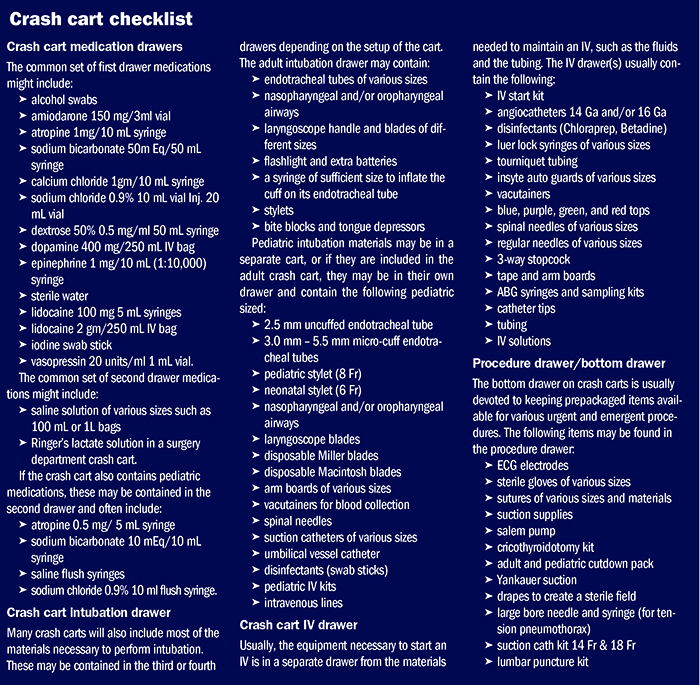Crash cart management best practices for ASCs
Ambulatory surgery centers (ASCs) are one of the fastest-growing and highest-margin segments of the healthcare industry. As ASCs continue to expand, facilities need to enhance their workflow processes and procedures to help divert staff more toward actual patient care.
Crash cart management is an aspect for ASCs where time and costs can add up. Facilities must plan how they will address patient emergencies; what medications and supplies they will need; how they will procure those medications; and how they will store and dispose of them.
Crash cart contents and required quantities typically follow the American Heart Association Guidelines for Cardiopulmonary Resuscitation (CPR) and Emergency Cardiovascular Care (ECC), as well as its algorithms and training for either Basic Life Support (BLS) or Advanced Cardiovascular Life Support (ACLS).
Know the drugs, items needed
There is no one size fits all when it comes to crash carts. The size, shape, and contents of a crash cart may be different between facilities. A crash cart in an urgent care facility may differ from one in a surgical facility, and even between departments in the same facility. For example, an adult crash cart is set up differently than a pediatric one.
ASCs should consider:
• facility type, licensure requirements
• types of procedures performed, level of sedation, and patient risk factors
• Centers for Medicare and Medicaid Services requirements, if the facility accepts Medicare patients
• additional requirements for accreditation the facility is seeking to achieve
• State Board of Health Guidelines, if the state has them.
Recommended crash cart formularies are defined by state and federal departments of health licensing agencies, as well as the appropriate accrediting bodies depending on facility type and procedure classifications.
Always follow your compliance officer’s and/or medical director’s guidelines for required contents and quantities for your specific facility and procedure categories.
That being said, there are common ACLS crash cart medications and items that should always be included, as directed by the ACLS Training Center (sidebar, Crash cart checklist). Note that expiration dates should be checked at least once monthly.
Automate your ASC
Automation is an efficient way to keep track of crash cart medications and manage costs. The Joint Commission’s Medication Management Standards (section MM 03.01.03) encourage the use of technology for documentation and compliance.
Risk, time, cost, and process are four major challenges ASCs face when it comes to crash cart management:
• RISK—Tracking expiration dates and reordering crash cart supplies can be a compliance risk. Without proper cart maintenance, necessary medications might not be available in the event of an emergency and could cause patient harm.
• TIME—Manually checking and ordering medications is not efficient for staff members.
• COST—Tangible costs include purchasing in bulk versus smaller quantities. Shipping costs can be as high as the medication itself when ordered and shipped individually, and medications purchased in bulk may be wasted if they expire. Intangible costs include wages paid to document inventory and order replacements, potential fines or shut down for non-compliance.
• PROCESS—It can be difficult to manage the contents and status of multiple crash carts. An auto-replenishment program/crash cart tracking system can help with the time-consuming, labor-intensive process of maintaining a medical emergency crash cart. This provides a facility with a central platform with real-time status of the medications. Often, having the ability to see all crash cart contents and statistics online is helpful, especially during accreditation inspection time.
Many ASCs have limited resources and people. To start the automation process, an ASC should speak with its field sales consultant (FSC) about implementing a crash cart tracking system. Provide your FSC with medication size and strength, unit of measure, and quantity, then work together to determine costs and ensure current medication quantities are accurate when you implement the program.
An automated program will help manage the cart, keeping the medications up to date with the quantity needed throughout the year. An auto-replenishment service helps ensure that enrolled emergency medications are tracked and automatically replaced just before expiration to maximize shelf life and most importantly, ensure readiness.
By keeping accrediting body guidelines accessible, knowing which drugs your ASC needs, and automating your crash cart, a facility can reduce the risk of missing or expired medications, be prepared for audits, and remain compliant per accreditation requirements.
—Kelli Chambers is surgical solutions specialist at Henry Schein Medical and has 25 years in the healthcare industry. Lynda Goodrich is medical marketing product manager at HealthFirst and has more than 30 years in the medical and surgical fields.
References
ACLS Training Center. Crash Cart Supply & Equipment Checklist. March 18, 2021.
American Heart Association. 2020 American Heart Association Guidelines for CPR and ECC.
The Joint Commission. Crash Cart Preparedness Quick Safety Bulletin. Issue 32. April 2017.


 Free Daily News
Free Daily News